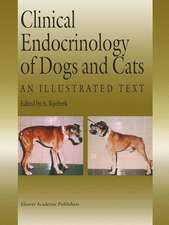Medical History and Physical Examination in Companion Animals
Editat de A. Rijnberk, H.W. de Vriesen Limba Engleză Hardback – 31 mar 1995
| Toate formatele și edițiile | Preț | Express |
|---|---|---|
| Paperback (1) | 1420.13 lei 6-8 săpt. | |
| SPRINGER NETHERLANDS – 31 mar 1995 | 1420.13 lei 6-8 săpt. | |
| Hardback (1) | 1423.02 lei 6-8 săpt. | |
| SPRINGER NETHERLANDS – 31 mar 1995 | 1423.02 lei 6-8 săpt. |
Preț: 1423.02 lei
Preț vechi: 1497.92 lei
-5% Nou
Puncte Express: 2135
Preț estimativ în valută:
272.28€ • 284.32$ • 224.85£
272.28€ • 284.32$ • 224.85£
Carte tipărită la comandă
Livrare economică 16-30 aprilie
Preluare comenzi: 021 569.72.76
Specificații
ISBN-13: 9780792330370
ISBN-10: 0792330374
Pagini: 376
Ilustrații: X, 376 p.
Dimensiuni: 155 x 235 x 27 mm
Greutate: 0.75 kg
Ediția:1995
Editura: SPRINGER NETHERLANDS
Colecția Springer
Locul publicării:Dordrecht, Netherlands
ISBN-10: 0792330374
Pagini: 376
Ilustrații: X, 376 p.
Dimensiuni: 155 x 235 x 27 mm
Greutate: 0.75 kg
Ediția:1995
Editura: SPRINGER NETHERLANDS
Colecția Springer
Locul publicării:Dordrecht, Netherlands
Public țintă
ResearchCuprins
1 Introduction.- 2 The rationale for this approach.- 3 A few concepts and an introduction to the diagnostic process.- 4 Methods and instruments.- 5 Medical records.- 6 The history.- 7 General impression.- 8 General examination.- 9 Respiratory system.- 10 Circulatory system.- 11 Digestive tract.- 12 Kidneys and urinary tract.- 13 Female reproductive tract.- 14 Male reproductive tract.- 15 Skin, hair, and nails.- 16 Mammary glands.- 17 Locomotor system.- 18 Nervous system.- 19 Eyes.- 20 Ears.- 21 Endocrine glands.- 22 Behavior.- 23 Emergencies.- 24 Handling and restraint - Injections and blood collection.- 25 Preanesthetic examination and health certification.- 26 Birds.- 27 Small mammals.
Recenzii
` ... ein hochintelligentes, ausgezeichnetes Buch. ... eine ausgezeichnete Schule der klinischen Untersuchung. '
Dr. H.-O. Schmidtke in Berliner u. Münchener Tierärztliche Wochenschrift 106:10 (1993)
` ... eine wertvolle, vorzüglich illustrierte Anleitung. ... sympathisches Buch ... '
Prof.Dr. Peter F. Suter in Schweiz.Arch.Tierheilkunde 135:9 (1993)
` ... eine so detaillierte Beschreibung ... wie sie bisher nicht auf dem Markt war. ... die sehr gut gestalteten, schematischen Zeichnungen. ... mit dem vorliegenden Buch ein Erfahrungsschatz veröffentlicht, aus dem so mancher Praktiker noch schöpfen kann und der Studierenden unbedingt zu empfehlen ist. '
Deutsches Tierärzteblatt 9:1 (1993)
` Das Buch sollte in keiner Kleintierpraxis fehlen und sei auch jedem Lehrer in den klinischen Fächern empfohlen. '
Wiener Tierärztliche Monatsschrift 6 (1994)
` ... eine echte Hilfe ... pädagogisch so gut aufgebaut ...
So ist es allen zu empfehlen ... '
Tierärztliche Praxis 3 (1994)
` The book is well written, concise and yet very well directed. From my point of view, it should be required reading (and passing) before a studient is allowed to move on to the clinics and the responsibility for the care of patients.'
Stephen J. Ettinger, DVM, California Animal Hospital
` As a teacher of undergraduate veterinary students the text provides excellent information for them to learn how to complete and to understand the clinical examination of companion animals. As amature veterinarian the book reinforces and exposes all the `old' skills we used to learn. I commend it to undergraduate veterinary students and to veterinarians who wish to revise, relearn, or remind themselves of examining methods and procedures in small animal medicine. '
Boyd Jones in New Zeland Veterinary Journal
Dr. H.-O. Schmidtke in Berliner u. Münchener Tierärztliche Wochenschrift 106:10 (1993)
` ... eine wertvolle, vorzüglich illustrierte Anleitung. ... sympathisches Buch ... '
Prof.Dr. Peter F. Suter in Schweiz.Arch.Tierheilkunde 135:9 (1993)
` ... eine so detaillierte Beschreibung ... wie sie bisher nicht auf dem Markt war. ... die sehr gut gestalteten, schematischen Zeichnungen. ... mit dem vorliegenden Buch ein Erfahrungsschatz veröffentlicht, aus dem so mancher Praktiker noch schöpfen kann und der Studierenden unbedingt zu empfehlen ist. '
Deutsches Tierärzteblatt 9:1 (1993)
` Das Buch sollte in keiner Kleintierpraxis fehlen und sei auch jedem Lehrer in den klinischen Fächern empfohlen. '
Wiener Tierärztliche Monatsschrift 6 (1994)
` ... eine echte Hilfe ... pädagogisch so gut aufgebaut ...
So ist es allen zu empfehlen ... '
Tierärztliche Praxis 3 (1994)
` The book is well written, concise and yet very well directed. From my point of view, it should be required reading (and passing) before a studient is allowed to move on to the clinics and the responsibility for the care of patients.'
Stephen J. Ettinger, DVM, California Animal Hospital
` As a teacher of undergraduate veterinary students the text provides excellent information for them to learn how to complete and to understand the clinical examination of companion animals. As amature veterinarian the book reinforces and exposes all the `old' skills we used to learn. I commend it to undergraduate veterinary students and to veterinarians who wish to revise, relearn, or remind themselves of examining methods and procedures in small animal medicine. '
Boyd Jones in New Zeland Veterinary Journal





